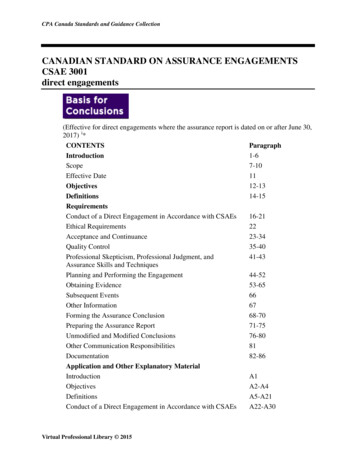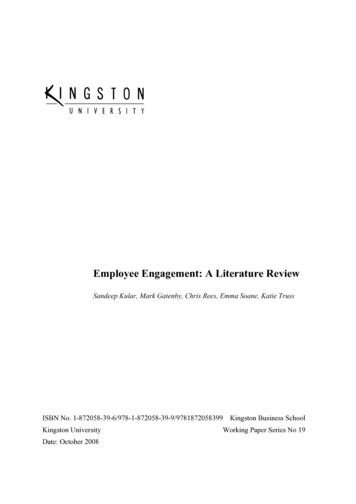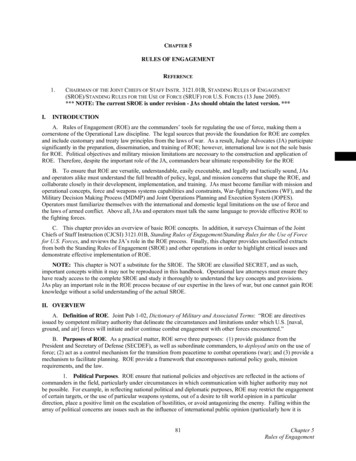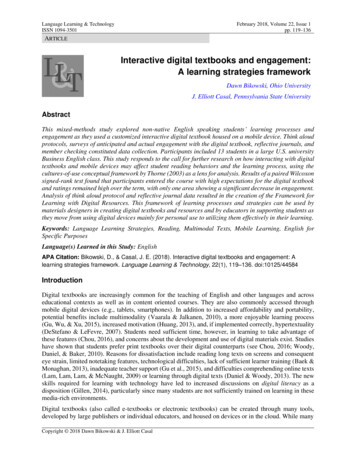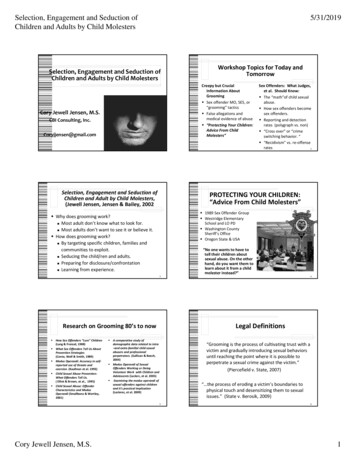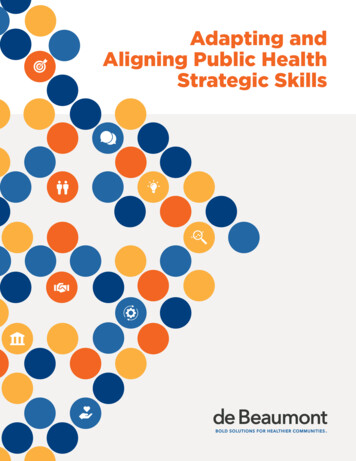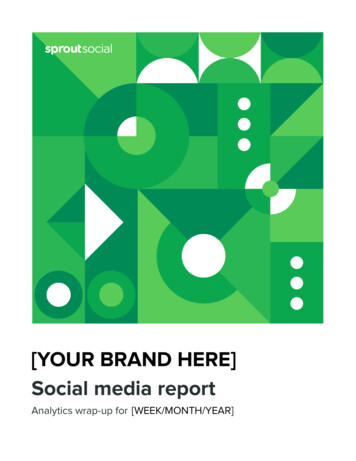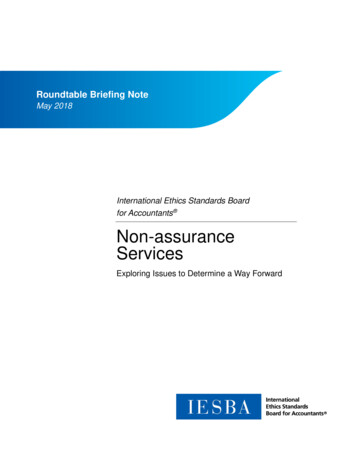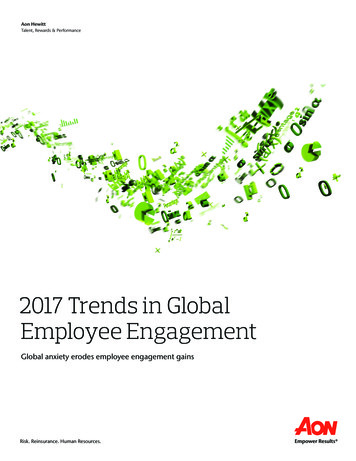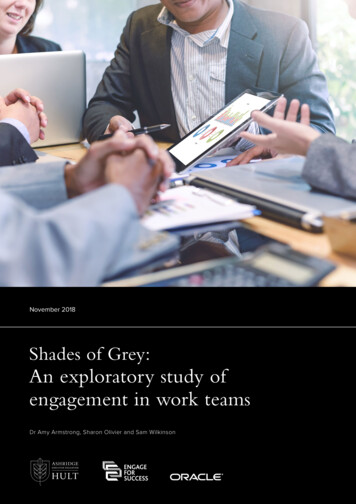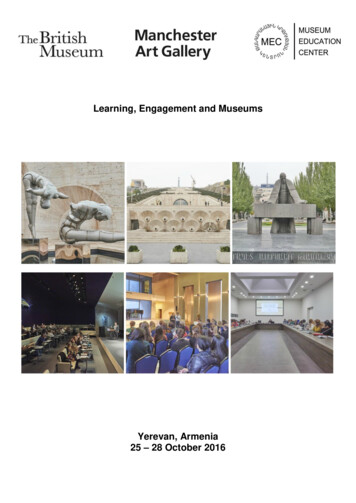
Transcription
Learning, Engagement and MuseumsYerevan, Armenia25 – 28 October 2016
Learning, Engagement and Museums, a collaboration between the Museum Education Centre,Armenia, Manchester Art Gallery and the British Museum’s International Training Programme (ITP),took place between 25 – 28 October 2016 in Yerevan, Armenia. Including a mix of presentations,shared case studies, group workshops and facilitated discussions, the conference focused onmuseum learning and engagement programmes as well as professional development, and offeredcolleagues both in Armenia and internationally the opportunity to share stories, ideas and challengesin their current work. ITP fellows, generously supported by the Marie-Louise von MotesiczkyCharitable Trust, were invited to facilitate and feed into project working groups and to demonstratehow the ITP has enhanced their expertise and professional growth. Delegates were also invited toanalyse their current skills and opportunities for skills-building within the museum sector.Press Conference with Davit Poghosyan, Ronan Brindley, Hayk Mkrtchyan, Claire Messenger and Marine MkrtchyanA global partnershipLearning, engagement and museums proves the wide-reaching and essential value of globalnetworks and partnerships and stemmed from conversations between the Museums EducationthCentre, Armenia and Manchester Art Gallery at the ITP’s 10 Anniversary event Creating museums ofworld stories which took place in Mumbai from 20 - 21 November 2015 with the support of the GettyFoundation. The Yerevan workshop brought together colleagues from seven countries across theinternational heritage sector to form new networks and discuss ways in which museums can worktogether, both within Armenia and worldwide.‘A diverse collaborative project, focusing on specific topics and with a 'mini ITP' format, Learning,Engagement and Museums was a model for wide collaborative experiences between ITP fellows andtheir Armenian colleagues, who were invited to take part through an open application process. Asmentioned during the conference and interviews, museum education projects and public engagementare one of the crucial parts of the museum transformation process in Armenia. So, the topic of theconference was already highly relevant to all participating museums and organizations.Specially developed toolkits and the opportunity for group work and sharing ideas of differentapproaches can be another useful skill development model for Armenian museums and also withinthe ITP network. Positive feedback and materials from museum professionals and organizations canbe seen as an indicator of success of such kinds of collaborations supported by the ITP and itspartner museums. Four projects were created and presented during the conference, and the
presentations and case studies given are a great way of personalising the experience gained duringthe ITP, inspiring new projects within the network of ITP and Armenian professionals’.Davit Poghosyan, Lecturer (PhD), Armenian State Pedagogical University afterKH. Abovyan, Chair of Museology, Armenia (ITP 2015)‘The International Training Programme is a globally renowned network for museum and heritageprofessionals. Annual activities in the frame of the ITP open up new opportunities and possibilities tocreate and build a sustainable future for museums. In fact we can call the ITP a big database forcreative, innovative and fresh ideas that can be received through global partnerships andcollaboration. And partnership will be much stronger when you are able to accept newcomers to yournetwork. This has been nicely done during workshop “Learning, Engagement, Museums” in Yerevan.Together with local specialists, ITP fellows and key experts from the UK and Germany tried to shareexisting trends in museums worldwide in order to develop new strategies in audience engagement,public and learning programmes. We tried to introduce with the best of Armenian cultural heritage inorder to strengthen future partnerships and to pin Armenia on the map of the International TrainingProgramme’s global network’.Hayk Mkrtchyan, Coordinator, Museum Education CentreHayk Mkrtchyan introducing Leaning, Engagement and Museums at Cafesjian Centre for the Arts‘Manchester's approach to this project was to re-examine what works in its own learning programmesand to see if these ideas resonate with international peers and delegates. The aspiration is that this'trading' of experiences at an international level has the potential to give rise to new priorities anddimensions for learning and educational programmes, ones that we might not think of in isolation.In addition, Manchester as a growing city within the UK has always been aware and mindful of itsinternational connections. At this crucial period in history when division and isolation appear to be inthe ascendancy and when the value of tolerance is under threat, it is even more vital that we use ourcultural connections to foster dialogue. Museums and cultural collections can promote nationalidentity in a positive, confident and connecting manner. Learning and engagement programmes havethe ability to enhance this further, to encourage dialogue and to aid cultural sharing andunderstanding’.Ronan Brindley, Head of Learning, Manchester Art Gallery
‘The International Training Programme (ITP) works to develop a sustainable global network ofinspired museum and heritage professionals through sharing knowledge, skills and experiences. Inorder to build on the learning achieved by fellows, and to strengthen the network of colleagues aroundthe world, we work throughout the year on developing plans which support this.When colleagues in Armenia suggested a conference and workshop that would enhance our relationswith our fellows and give us the opportunity to cascade training and support development in-country,we were delighted to be part of this project. Not only was there an opportunity to share experiencesand learning with our colleagues in Armenia but the potential outcomes, aimed at supportinginstitutions in planning, developing and delivering their own learning and engagement offerings, wassomething we could share with the rest of our alumni. Working with fellow professions and theopportunity to visit in museums in and around Yerevan, would also help give us a strong steer as tohow best we might be able to support Armenian museums in the future.The post-fellowship opportunities are essential to the core objectives of the ITP. These projectsensure those in our network keep talking and working together after the summer programme. Theyprovide further training and research opportunities, and open up potential collaborations. Theypromise a lifelong commitment to our network from the British Museum, our partners and from ourfellows’.Claire Messenger, Manager, International Training Programme, British MuseumWhy learning is important in the modern museumThere are three principle responsibilities for museums and galleries. The first is to the collections andobjects we hold – the things we show and the things we keep. Our collections and exhibitions give usour identities and definitions and we use them to create and share narratives. Our second is to ouraudiences and visitors – that we extend and develop our audiences, connect with them in new waysand involve them in the life of the museum. Our third is that we build plans to survive – develop ourability to be sustainable, so that museums, galleries and their connections will thrive and continue toattract audiences.Ronan Brindley introducing Leaning, Engagement and Museums at Cafesjian Centre for the Arts
Learning and engagement is a constant and, I argue, the vital thread that runs through these threeresponsibilities. In a simple way, it is the combining and activating ingredient. We seek moreknowledge about our collections and find new ways of displaying them. We learn about and with ouraudiences, identifying new ways of connecting with them, building new narratives in collaboration withthem, working in partnership to widen the museum’s knowledge base and developing the museumenvironment as a social learning space. Our appetite for learning can also feed sustainability,creating and diversifying a demand for what we do, identifying new ways of doing it, and creatingpowerful arguments for continuation.Amongst the key challenges of the modern world are intolerance, division and social isolation.Museums and galleries are a ‘micro-dot’ in the social landscape. But we have the ability and thecollections to encourage understanding, enhance positive and confident forms of identity and buildsocial cohesion. Learning and engagement has to be at the heart of our attempts to be a progressiveand dynamic museum community.In conclusion, I wish to add a final responsibility and that is to ourselves. We are learners first. Weneed to nourish this, share our expertise, build networks and bring this to fore, both in the museumswe represent and as a collective and international community.Ronan Brindley, Head of Learning, Manchester Art GalleryThe ITP team and fellows at the Armenian Genocide Museum-InstituteLearning, Engagement and Museums - The case studiesOn day one UK and Programme partners, ITP fellows and Armenian colleagues shared the aims,challenges and processes of learning and engagement programmes at their institutions, along withadvice and guidance for future projects.
Ronan Brindley, Manchester Art GalleryWhere: Manchester, EnglandContext:Attracting local families into a museum in a city centre is difficult when families who come into the citycentre are often too busy doing lots of other things. Once families visit the family space in themuseum, the next challenge is to encourage them to spend time in galleries of the museum and artgallery.Work being done:To create a sense of a social space a family space has been secured within the building and plantsplaced at the entrance to soften the look of the museum. Previously families were told they must stayfor an entire session, but to encourage families with busy schedules, family programmes havebecome more like ‘drop-in’ sessions. Families can come and go as they please. Picnic areas havebeen set up for families, making life easier and cheaper for parents with multiple children. On thethird Saturday of the month the Art Gallery opens its doors earlier for families with autistic children.Elaine Addington, Open Museum GlasgowElaine Addington presenting at Cafesjian Centre for the ArtsWhere: Glasgow, ScotlandContext:Life expectancy in Glasgow is lower than in Scotland. Deprivation, health problems and a lack ofskilled workers is costing Glasgow money and Elaine believes this is a challenge that the museumcan contribute to overcoming.Work being done:Elaine spoke about connecting objects, people and place; putting the collection of her museum at theheart of Glasgow’s Community as a means of inspiring conversation and a sense of community.Elaine works with hard to reach communities through handling kits, community exhibition spaces andcreating traveling exhibitions contributed to by targeted communities.Current policies include Homelessness and overcoming isolation and stigma, creating an age friendlycity in a changing city and providing educational support to young people recovering from mentalhealth issues.
Andrea Martin, The Collection: Art and Archaeology in LincolnshireWhere: Lincoln, EnglandContext:Encouraging teenagers into museums and art galleries as young adults. Working with schools in thecounty and a focus group of teenagers to find out what is missing from the curriculum in local schools.Work being done:Lincoln Summer School- an immersive week long session of art techniques not available to teenagersin school or locally; enabling 13-16 year olds to gain confidence in asking questions, discussing andspending time in new environments before going to college and/or university. The course began as alife drawing summer school but more recently has adapted to the teenagers interests to includephotography and portraiture sessions.Shreen Taher, Children’s Museum at the Egyptian MuseumShreen Taher presenting at Cafesjian Centre for the ArtsWhere: Cairo, EgyptContext:A children’s museum within the Egyptian Museum presenting the history of Egypt with Lego.Students from the age of 4 can therefore touch objects without any restrictions. Lots of school groupsvisit but in order to attract families, activities must impress the parent.Work being done:A topic from history is selected with a theme, for example music or language. Worksheets pre- andpost-visit to the museum are created in line with the age of students participating. An exampleincludes ‘Tut in trouble’: at the museum children try to find the objects belonging to King Tutankhamenin order to prepare him for burial. They fill in a worksheet as they go and follow up with moreinformation about the objects and mummification using different resources. Once the children havefound the objects they prepare a replica King Tut for the afterlife and perform the funeral procession.Courses are run in English and Arabic to attract as many schools as possible and courses incorporatelearning French, English and German to appeal to parents who will bring their children to the museumas a result.
Christine Fischer, Grassi MuseumWhere: Leipzig, GermanyContext:The museum objects do not easily link to the needs of the local community, currently large groups ofimmigrants are suffering from feelings of disconnect with their new home. There is a demand tostreposition ethnological museums in the 21 Century.Work being done:Christine categorised her work under sub-headings including multiperspectivity, ‘glocalization’,actuality, self-reflexivity and participation. Christine talked about the work which had already beendone: running gallery tours aimed at audiences from outside of Germany and given by localcommunity members, and spoke more generally about ways of creating an environment where peoplefrom all walks of life can have safe discussions.Workshops and discussions have been beneficial but Christine recognised that her work so far is onlythe beginning of a long process, to change the mind-sets of institutions and societies. Christine’sstrategy is to learn from completed projects and to start with small steps.Nairi Khachadourian, Komitas Museum-InstituteNairi Khachadourian presenting at Cafesjian Centre for the ArtsWhere: Yerevan, ArmeniaContext:A museum rectifying the loss of singing tradition in Armenia, due to a lack of publications in this fieldand heavy exposure to more recent technologies. The aim is to increase lullaby singing betweenparents and children, to reinforce this tradition from a young age.Work being done:Workshops with music, circle seating and meditative singing in a group are being held in the museum.Participants choose 4 songs they would like to sing before the workshop and a singing book is readyfor them upon their arrival. Lullabies are intimate and increase a sense of community for thoseparticipating. To encourage people who come to the classes to practice what they learnt at home, ithas been suggested that audio clips should be produced and uploaded online.
Narine Khachaturian, Hovhannes Toumanian MuseumWhere: Yerevan, ArmeniaContext:A Museum named after a famous Armenian writer for both adults and children. The art of storytellingand fairy tale narration is a part of Armenia’s intangible heritage which is being lost. These stories area part of Armenian heritage and ensure the dialects within the Armenian language are remembered;the Hovhannes Toumanian Museum encourages families to keep telling these stories to the nextgeneration.Work being done:Once a year since 2008 a festival of narration is held for competitors and audiences of all ages andprizes are awarded to the best performances. Performances initially take place in rural villages andthe final is held in Yerevan. The emotion, the traditional dress and the creativity of participants adds tothe overall performance. Initially participants are timid but their confidence grows throughout thefestival.Ani Avagyan, National Gallery of ArmeniaAni Avagyan, speaking at the Armenian Genocide Museum-InstituteWhere: Yerevan, ArmeniaContext:An institution where object collecting increased during 70 years of Soviet rule, now containing 40,000pieces of art from Armenia, Russia, Europe and Asia. However, it has only been since 2009 thateducational activities have developed and this year (2016) an education department, consisting of 3members of staff, will open.
Work being done:The aim is to fill the gaps in mainstream institutions via interactive education programs, working withschools throughout the year, lectures, printed educational material, game planning and social media.Establishing a relationship between museums and schools is an on-going project with the hope thatmuseum work and the national curriculum will be connected in the future. Since 2009 the number ofstudent groups visiting the National Gallery has risen from 5 to 123.Arusyak Ghazaryan, Yeghishe Charents Museum of Literature and ArtWhere: Yerevan, ArmeniaContext:In modern times new topics are interesting to children but, old objects are forgotten. There is aproblem with the absorption of national values in recent generations and the museum aims toincrease interest in various objects from different ages and cultures, in particular playing traditionalinstruments. Armenians should be able to distinguish between Armenian and eastern instruments.Work being done:Promotion of musical studies and learning to play national instruments to students aged 13-14 yearsin their own time and in schools. To create a modern and sensory experience, for example a screenwhere you can hear how instruments play whilst looking at them.Mikayel Badalyan, ‘Erebuni’ Historical and Archaeological Museum-Reserve, ‘Karmir Blur’ BranchMikayel Badalyan presenting at Cafesjian Centre for the ArtsWhere: Yerevan, ArmeniaContext:The ‘Erebuni’ Historical and Archaeological Museum-Reserve is currently aiming to bring newaudiences to museums and instil a sense of responsibility to look after Armenian heritage.
Work being done:An annual ’School of junior archaeologists’ consisting of 14 lessons and a 20 question exam aimed atteenagers. Based at a heritage site, museum and artificial site students gain practical and theoreticalexperience in archaeology and learning cuneiform. After passing the final exam students receive acertificate and badge, enabling them to visit heritage sites for free in the future and to bring family andfriends with them. Junior archaeologists have given talks about the collection to younger audienceduring European heritage week.Astghik Marabyan, Cafesjian Centre for the ArtsWhere: Yerevan, ArmeniaContext:To use the museum as a tool for integrating children from different ethnic and socio-economicbackgrounds; to integrate culturally and to merge with the social life in the countryside.Work being done:Engaging Syrian Armenians, aged between 12-14 years old, through art activities. Working with othermuseums and art galleries students were asked to present the cultural landscape of Armenia toenable people from different backgrounds to start thinking about Armenia as their home. The creationof an exhibition ‘The Landscape of my Country’ where during the opening ceremony children wereasked to explain their work to visitors.Marine Mkrtchyan, Russian Art MuseumMarine Mkrtchyan presenting at Cafesjian Centre for the ArtsWhere: Yerevan, ArmeniaContext:Before 2014 the Russian Art Museum had an excellent space and a good location but needed more.Marine went on the International Training Programme in 2014 for inspiration and to develop aprogramme for the Museum to work by.
Work being done:In 2015 educational initiatives were established culminating in 7 education programmes and 1summer school in 2016. In 2016 the Museum began creating education material for over 200 schoolsin Yerevan. Work still needs to be done to change people’s mind-sets about what a museum is andwho should visit them. The Museum is encouraging young people to visit and opening up the museumto new functions, such as holding marriage ceremonies.In summaryThe aim of theses case studies were to offer unique perspectives on engaging and educatingaudiences from diverse backgrounds. Despite the often localized context and different priorities ofeach institution, many interesting common themes were revealed, including: Partnerships – how they help you achieve more and provide additional resources.Diversity – making programmes work for you, your collections and your space.Tolerance – awareness of cultural differences and being aware of stereotypes.Self-awareness – personal development to help you deliver more effectively.Atmosphere – leadership in institutions supporting and encouraging the programmes that areproposed.Competition – the need to ‘raise our game’ in light of programmes in other institutions andattractions.Awareness – ‘filling a gap’; looking around, and outside of, the sector to see what youraudience/community needs.‘I was amazed by the passion of the experts present in the workshop and I greatly appreciatedtheir readiness to help and share their own knowledge as they gave me great ideas that I wouldlike to apply in the future’. Nathalie El Alam, Archaeologist, Beirut National Museum (Lebanon,ITP 2012)Workshop groups, Cafesjian Centre for the Arts
Learning and Engagement Workshop - The remitAfter sharing case studies with colleagues across the sector, delegates were split into groups, basedon their individual role profiles and areas of interest, to develop their own learning and engagementprojects. Each working group was allocated a target audience and asked to plan a session,programme, resource, event or activity on: Family Learning; Teenage-friendly Engagement; NewAudiences; and working with Older Audiences.Delegates were asked to consider aims and objectives, project scope, budget, timescales, risks andbenefits, and how their projects could be supported through partnerships: whether nationally orinternationally. By the end of the sessions delegates had identified and planned a viable learning orengagement project which could be delivered in their institutions, identified partners resources andpotential risks, developed strategies to overcome challenges and created a framework to assess thesuccess and sustainability of the project.The projectsFamilies against War – Family Learning.With Haykuhi Avagyan, Ronan Brindley, Arusyak Ghazaryan, Zhanna Manukyan, Davit Poghosyan,Tatev Saroyan, Shreen Taher, Nigel Tallis.Families against War Workshop, Cafesjian Centre for the ArtsMy group focused on family learning, and the name of our project was “Families against War”, whichwas suggested as a possible title. Our aims were to shed light on the memories of war and militaryfamilies as a way of documenting this aspect of Armenian intangible cultural heritage, where olderpeople who served during war will tell their experiences to their families, especially children, in aspecial programme focusing on families involved in current conflicts. The programme will approach 10families that will be selected to participate. More than four Armenian museums will be involved incooperation with Armenian ministry of deference and Armenian NGOs working with war families.The duration of this program will be three months - all these experiences will be recorded on theArmenian Museums’ YouTube channels. The programme aims to engage war families with Armenianmuseums, and to highlight experiences of war. Special educational programs in the four Armenianmuseums will be designed aiming to engage those families.Shreen Taher, Director, Children’s Museum at the Egyptian Museum, Cairo.
The Teen Council of Museums – Teen Engagement.With Ani Avagyan, Mikayel Badalyan, Nathalie El Alam, Rebecca Horton, Liana Karapetyan, AstghikMarabyan, Andrea Martin, Marine Mkrtchyan.The outline idea for this project was to establish a teen council for museums, creating an activelyengaged audience who would be involved directly within the heritage sector. The project wouldcreate a council of 15 teenagers which would have twice monthly meetings, with discussions andactivities over a 4 month period including two activities when members could invite a ‘ 1’. By bringingin a ‘ 1’ there is a more friendly and inclusive atmosphere, and the council reaches out to moreteenagers.The project would maintain a relationship with the old teen council in many ways, including invitingthem back to special events and creating social platforms and webpages to stay connected, therebyencouraging the sustainability of the audience The teen council of museums would be an annualprogramme, with new council members joining each year.Teen Council of Museums Workshop, Cafesjian Centre for the ArtsThree museums would be at the core of the project - Cafesjian Centre for the Arts; National Gallery ofArmenia and Aram Khachaturian Museum and each cycle of ‘councils’ would be a year in theplanning, delivery, evaluation - and celebration!The aim of the project was not just to encourage teenagers into the museums, to give them a senseof community and place, but the process would give the participants confidence, life skills such asteam working and decision making and a professional orientation. This collaborative approach wouldalso provide a continual dialogue with the teenage audience where their interests and opinions can beheard.Andrea Martin, Collection Access Team Leader, The Collection: Art and Archaeology inLincolnshire, UK
The Colour of Sound – New Audiences.With Christine Fischer, Emma Croft, Nairi Khachadourian, Narine Khachaturyan, Anahit Mikayelyan,Tugba Tanyeri Erdemir, Artavazd Zakyan.The Colour of Sound is an interdisciplinary, international project, focusing in the first instance oncooperation between museums and universities in Armenia and Turkey. The aim is to investigate themusical heritage of Armenia, such as the music of Komitas Vardapet or the art works of SergejParadjanow, and its connection to other regions and countries, alongside its archaeological history.The project aims to work closely together with students, a target group which is not easy to reach for amuseum. The museums in this project will try to attract their target audience via contemporary media.In the first project phase the students are asked to research in archives and museums about an objectof their choice, focusing on the topic of Armenian musical heritage.In the second phase, students will translate their results into a visual language, creating short filmstogether with a visual artist. This way they can use old audio or visual databases, as well as modernmedia and their own material. These will serve as a basis for longer group films to be integrated intopermanent exhibitions currently under development in Armenia and eventually in Turkey. A publicpresentation will be followed by an event programme for the students, friends, families and visitors, tocelebrate success.Colour of Sound Workshop, Cafesjian Centre for the ArtsIt is a grand and long-term project; we expect it will take a year to approach partners and build theteam, deliver initial workshops and agree on a project plan. Research and the production of the shortfilms will take at least one year, with another half year to produce the final versions and six months tomeasure outcomes and evaluate. If the project is successful in Armenia and Turkey it could betransferred into other European countries, because of the strong link of the Armenian artists toEurope.The project will hopefully establish long-term cooperation between museums and universities.Students will get the possibility to work together with museum staff, to integrate new ideas, gaininsights for their work and to become the visitors of tomorrow.Christine Fischer, Performance and Audience Development, Grassi Museum, Leipzig
Building Memories – Older Audiences.With Elaine Addington, Mushegh Alaverdyan, Shubha Banerji, Ani Grigoryan, Sona Khechikyan,Marianna Manucharyan, Suren Manukyan, Claire Messenger, Hayk Mkrtchyan.Our group was full of ideas which were great to share and brainstorm. Finally, we decided on theidea of bringing together two museums, with the National Museum-Institute of Armenian Architectureafter Alexandr Tamanyan being at the lead and in Year One, partnering with the Armenian GenocideMuseum-Institute. The group wanted to focus on the people who had created and designed thesespaces, the architects and the builders and also the people who lived in and around them.We looked primarily at older people as this is the generation who would have designed, built and livein or near lived in the space, but the project was approached as a cross generational one, whichmight link older and younger generations through understanding and respect and shared commonhistories, whilst encouraging a shared pride in built heritage.Building Memories presentation at Cafesjian Centre for the ArtsThe group realised that costs would be minimal as the project slotted nicely into their exhibition/ publicprogramming priorities and agreed that this project could be adapted to suit many different locationsacross Armenia, and talked of it becoming an annual event.Elaine Addington, Open Museum Curator, Glasgow Museums Resource Centre, UKThe outcomesAs well as providing advice and feedback to delegates, facilitators from each working group wereasked to contribute to the production of four ‘toolkits’ - resource materials based on the workshopprojects developed, to share with colleagues across the sector in Armenia and among ITP alumni.These toolkits aim to support institutions in planning, developing and delivering their own learning andengagement offerings.There will be a separate toolkit for each workshop project – with detailed notes on th
Learning and engagement is a constant and, I argue, the vital thread that runs through these three responsibilities. In a simple way, it is the combining and activating ingredient. We seek more knowledge about our collections and find
